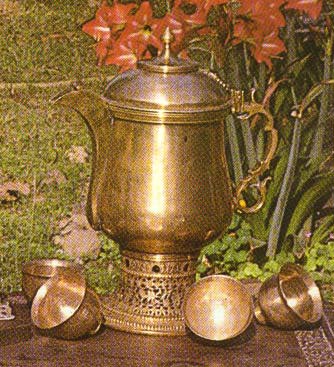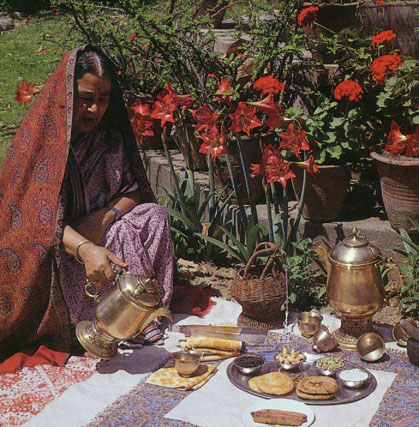Kashmiri
Sama:va:r
There
is no home in Kashmir that does not have a samovar. Each family has one
or two samovars. Kashmiris make tea in the samovar. Kashmiris are very
fond of tea. That is why any time is considered tea time.

Koshur
Sama:va:r with 4 khae:s (cups)
Inside a samovar
there is a fire-container in which charcoal and live coals are placed.
Around the fire-container there is a space for water to boil. Tea leaves,
sugar, cardamom, and cinnamon are put in the water.
Samovars are
not of only one type. Some samovars, in which only one or two cups of tea
can be made, are very small. Other samovars, in which hundreds of cups
of tea can be made, are very big. Samovars are made of copper or brass.
Kashmiris can
make two or three types of tea in the samovar. The kehvi is the favorite
tea of Kashmiris. This tea is also call mogil cha:y. There is a special
tea for making it. It is called bambay cha:y. The bambay cha:y, sugar,
cardamom, cinnamon, and almonds are boiled in water, but no milk is added.
The second
type of tea is dabal cha:y. It is made with bambay cha:y, sugar, cardamom,
and almonds. Milk, however, is also added. Kashmiri Pandits serve dabal
cha:y at weddings and on feasts.
The third type
or tea is called shi:r' cha:y. This type is not made with bambay cha:y.
There is another kind of tea used for making that. It is prepared with
bicarbonate of soda, salt, milk, and cream (mala:y). It has a very pleasant
color. Shi:r' cha:y also is a typically Kashmiri tea, but not everyone
likes it.

Tea being
poured from a sama:va:r into a kho:s (cup).
A kangir,
the traditional Kashmiri fire-pot, is nearby.
Recently, some
Kashmiris have started drinking Lipton tea. But even now, the favorite
tea of Kashmiris is kahvi. It is said that good kanvi cannot be made without
the samovar.
It is difficult
to say when the samovar was first introduced into Kashmir. In addition
to Kashmir, the samovar is also found in Russia and Persia. Kashmiri tea
can only be enjoyed in a Kashmiri kho:s (cup).
Text
reproduced from:
An
Introduction to Spoken Kashmiri
by Braj B.
Kachru
Department
of Linguistics, University of Illinois
Urbana, Illinois
61801 U.S.A.
June, 1973
Pictures
scanned from:
De
Leij
Culinary Art
of Kashmir
by Shyam Rani
Kilam and S. S. Kaul Kilam
|

